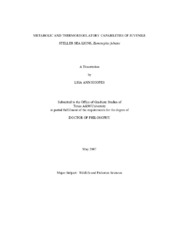| dc.contributor.advisor | Rooker, Jay R. | |
| dc.contributor.advisor | Worthy, Graham A.J. | |
| dc.creator | Hoopes, Lisa Ann | |
| dc.date.accessioned | 2010-01-14T23:55:54Z | |
| dc.date.accessioned | 2010-01-16T01:42:54Z | |
| dc.date.available | 2010-01-14T23:55:54Z | |
| dc.date.available | 2010-01-16T01:42:54Z | |
| dc.date.created | 2007-05 | |
| dc.date.issued | 2009-05-15 | |
| dc.identifier.uri | https://hdl.handle.net/1969.1/ETD-TAMU-1390 | |
| dc.description.abstract | Maintaining thermal balance is essential for all homeotherms but can be especially challenging for pinnipeds which must regulate over a variety of ambient temperatures and habitats as part of their life history. Young pinnipeds, with their immature physiology and inexperience, have the additional expense of needing to allocate energy for growth while still dealing with a thermally stressful aquatic environment. With the immense environmental and physiological pressures acting on juvenile age-classes, declines in prey resources would be particularly detrimental to survival. The goal of the present study was to examine the metabolic and thermoregulatory capabilities of juvenile Steller sea lions to better understand how changing prey resources indirectly impact juvenile age classes. Data collected from captive Steller sea lions suggest that changes in body mass and body composition influence the thermoregulatory capabilities of smaller sea lions in stationary and flowing water. Serial thermal images taken of sea lions after emergence from the water show vasoconstriction of the flippers compared to the body trunk to help minimize heat loss. Despite this ability to vasoconstrict, sea lions in poor body condition displayed a reduced tolerance for colder water temperatures, suggesting that decreases in prey availability which affect insulation may limit survival in younger sea lions. If reductions in prey availability (i.e., nutritional stress) were impacting western Alaskan populations, a reduction in energetic expenditures would be expected in these animals to cope. Measures of resting metabolism in juvenile free-ranging Steller sea lions across Alaska showed no differences between eastern and western capture locations, suggesting no evidence of metabolic depression in declining western stocks of sea lions. Finally, thermal costs predicted by a thermal balance model were compared to actual costs measured in the present study. Model output reliably predicted thermoregulatory costs for juvenile Steller sea lions under certain environmental conditions. Basic physiological measurements combined with the predictive power of modeling will allow for greater exploration of the environmental constraints on juvenile Steller sea lions and identify directions of future study. | en |
| dc.format.medium | electronic | en |
| dc.format.mimetype | application/pdf | |
| dc.language.iso | en_US | |
| dc.subject | metabolism | en |
| dc.subject | thermoregulation | en |
| dc.subject | lower critical temperature | en |
| dc.subject | metabolic depression | en |
| dc.subject | nutritional stress | en |
| dc.subject | Steller sea lion | en |
| dc.title | Metabolic and thermoregulatory capabilities of juvenile steller sea lions, Eumetopias jubatus | en |
| dc.type | Book | en |
| dc.type | Thesis | en |
| thesis.degree.department | Wildlife and Fisheries Sciences | en |
| thesis.degree.discipline | Wildlife and Fisheries Sciences | en |
| thesis.degree.grantor | Texas A&M University | en |
| thesis.degree.name | Doctor of Philosophy | en |
| thesis.degree.level | Doctoral | en |
| dc.contributor.committeeMember | MacKenzie, Duncan S. | |
| dc.contributor.committeeMember | Neill, William H. | |
| dc.type.genre | Electronic Dissertation | en |
| dc.type.material | text | en |
| dc.format.digitalOrigin | born digital | en |


